
We continue the interview with the founder of the Nizhny Novgorod hackerspace CADR - Artem Poptsov (see also the
first part ).
What equipment is there? And in general, how much space?
The hackerspace can be divided into four main areas: the assembly-computer zone, the computer-assembly zone, the presentation zone and the kitchen. The following equipment is distributed to these zones:
- 3D printers: Reprap, ToyREP.
- Computers: 3 workstations, several laptops, single-board computers (Raspberry Pi, CubieBoard)
- Laser printer and scanner.
- Machines: drilling machine, sandpaper.
- Hand tools: drills, keys, chisels, files, screwdrivers, etc.
- Personal protective equipment: gown, goggles, respirators, gloves, etc.)
- Tools for soldering: soldering station with a hairdryer, soldering irons separately, associated expenditure.
- Measuring equipment: digital and analog oscilloscope, multimeters, calipers, micrometer, etc.
- Power sources.
- Microcontroller platforms: Arduino, STM32, ESP (8266, 32S, 12F).
- Various electronic distribution and related things: resistors, capacitors, transformers, LEDs, transistors, buttons, switches, wires, etc.
In addition, we have a small library of technical (and not only) literature, from where you can take books and magazines to read.
Particularly popular is the tea-drinking and liver-eating area - the work of the brain consumes a lot of energy, and it needs to be replenished somewhere. ;-)
 Tea and drink area.
Tea and drink area. Kadrobyba library.
Kadrobyba library.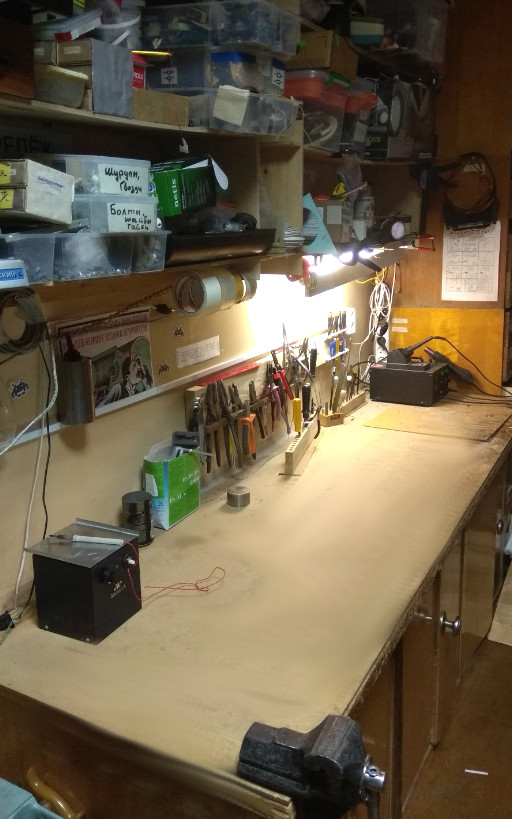 Assembly and computer zone.
Assembly and computer zone. Drilling machine.
Drilling machine.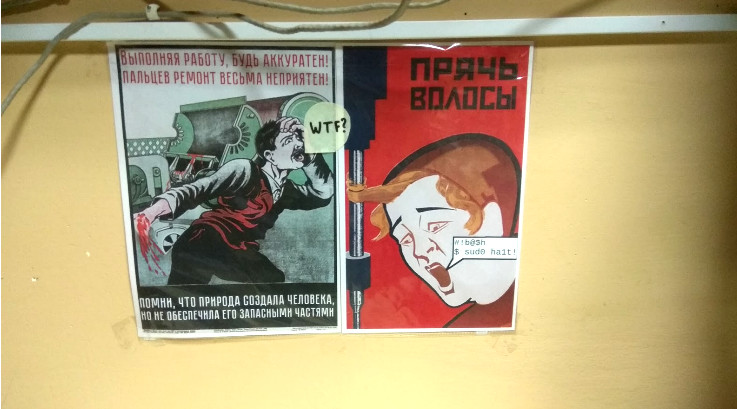 Motivating safety posters.
Motivating safety posters.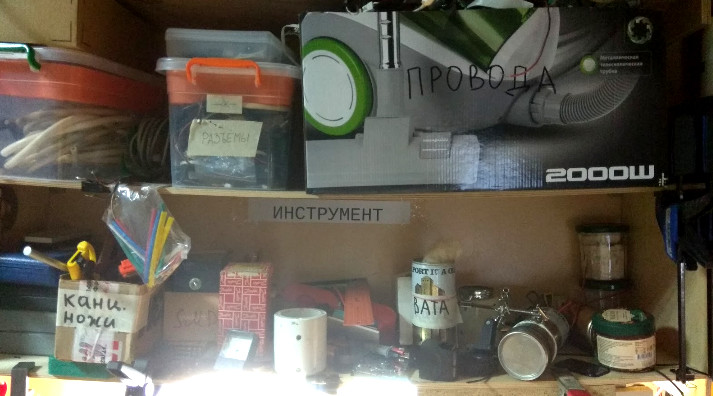 Shelf with tools above the assembly and computer zone.
Shelf with tools above the assembly and computer zone.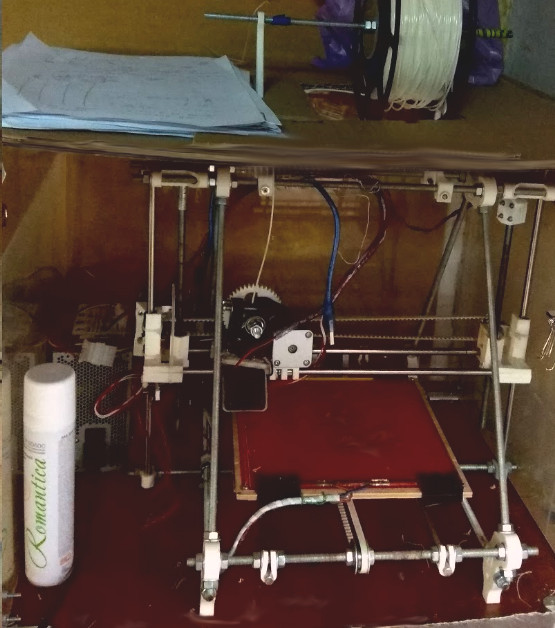 3D printer RepRap.
3D printer RepRap.What master classes held, spend, and plan? Hackathons
We conducted master classes on the Git version control system, there was a small master class on functional programming. We also have experienced electronic technicians who teach soldering and circuit design.
Every Wednesday and Saturday I spend Arduino-workshops: I teach programming and a bit of electronics.
Recently conducted a workshop on bit operations in PL C ++ and shift registers (
video recording ).
This year we did our first on-site workshop on microcontroller programming, together with
DEFCON NN .
 Master class on bit operations in PL C / C ++ and shift registers.
Master class on bit operations in PL C / C ++ and shift registers.Probably the participants lead their projects - a list of interesting projects
Many participants lead projects, usually under the guidance of experienced personnel. Experienced staff members do everything themselves and motivate others to work.
Here are some examples of projects:
- Ultrasonic Levitator - a device for levitating objects by means of ultrasound.
- "Parainformator" - a device for informing about the beginning of pairs in NRTK.
- 3D Plastic Recycling Machine - Recycle failed plastic parts back to a 3D printer material.
- “Cadrix” is a matrix printer, to which you can send tasks via Telegram-bot.
- Neurobot - a worm-driven robot (based on the OpenWorm project)
- Augmented reality glasses on ESP32S - taken as a basis for the project "Arduino Glasses a HMD for Multimeter" by Alain Mauer (it. Alain Mauer). By the way, there is a recording of my lecture with DEFCON NN on this topic.
- Three-color LED matrix.
- CADOORBOT
 Peter Tretyakov is testing the prototype of augmented reality glasses.
Peter Tretyakov is testing the prototype of augmented reality glasses.Do you communicate with other technical clubs (fablab, smith, etc.) in your city or in Russia, in the world?
NRTK has
its own TsMIT and, since we are now in symbiosis with the college, we have access to many resources of the local center.
In addition, we cooperate with the non-profit organization DEFCON NN (DC 7831) - we participate in conferences held by them.
Are there any directions for the promotion of robotics among schoolchildren?
In CADR, there are several cadres who are still studying at school and we help them with the development of programming and electronics.
At my second job (
at the Potsako Children's Center ), I
teach Petr Tretyakov (a student at the NRTC, a personnel manager and an excellent specialist) for
the “Mechatronics” course for schoolchildren, where we teach children everything that is required to create robots based on the Arduino platform.
Does the city help in any way?
Not at the moment. Perhaps we are just not actively advertising ourselves to be noticed by the city government. :-)
Do you do away workshops?
As mentioned earlier, this year we did our first on-site master class on programming microcontrollers, together with
DEFCON NN . It was quite fun, we were approached by local experts and learned how to program Arduino. In principle, it is not yet known who taught whom more. ;-)
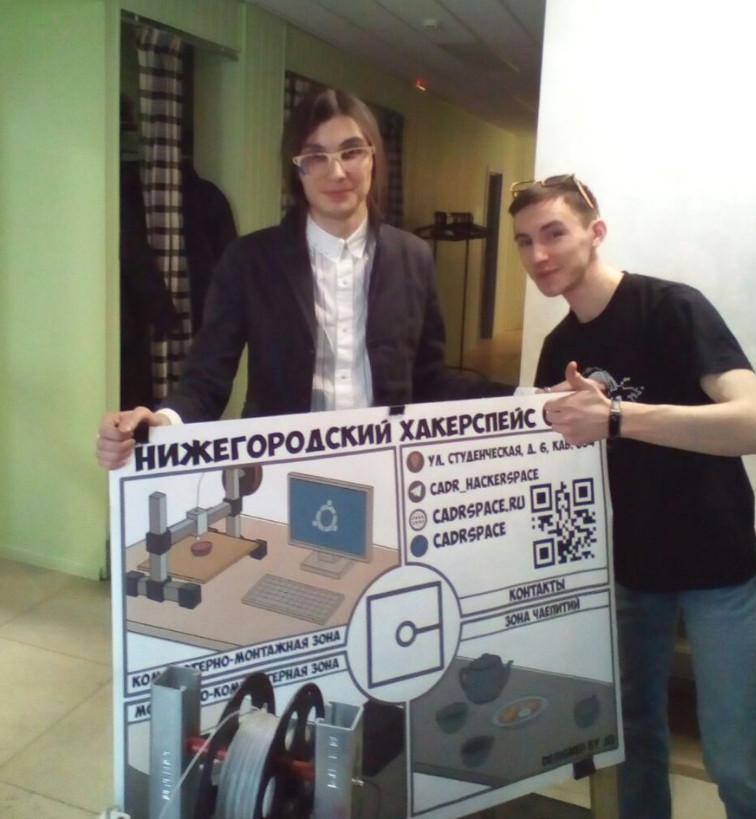
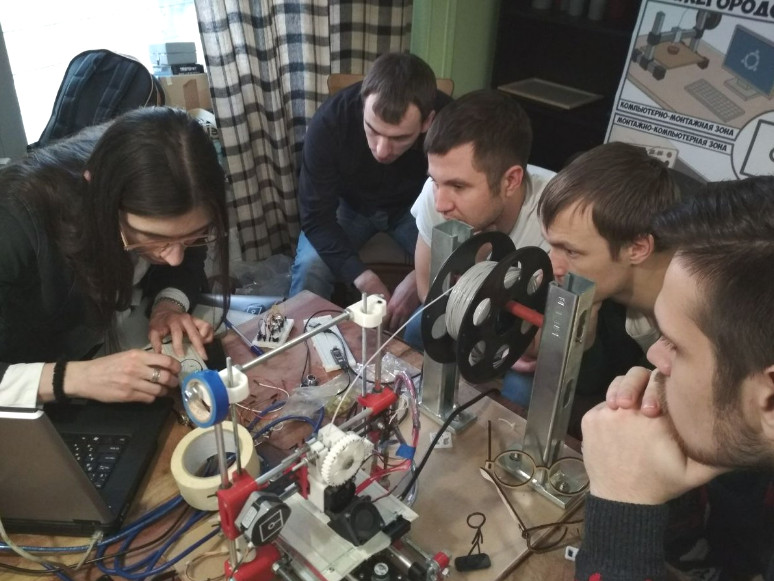
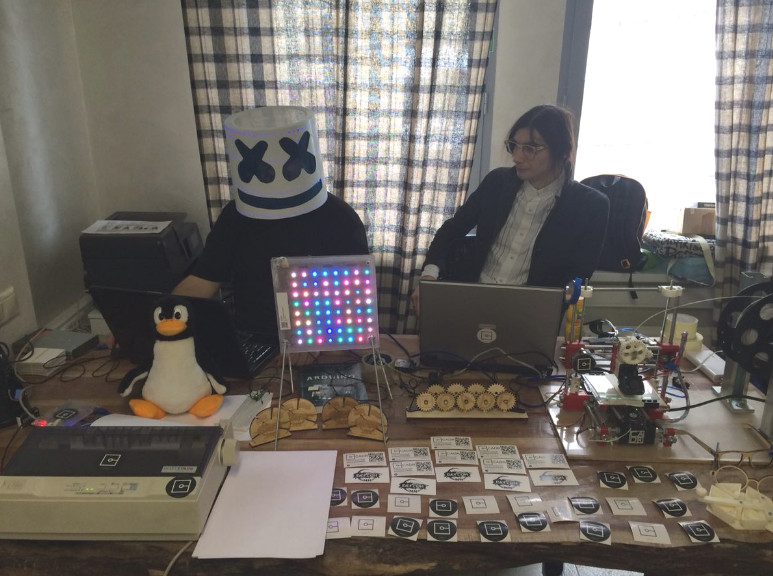 CADR hackerspace stand at DEFCON NN 0x08.
CADR hackerspace stand at DEFCON NN 0x08.Tell me about yourself - what interests you, what you do for your main job, whether hackspace is a hobby or a serious direction for you
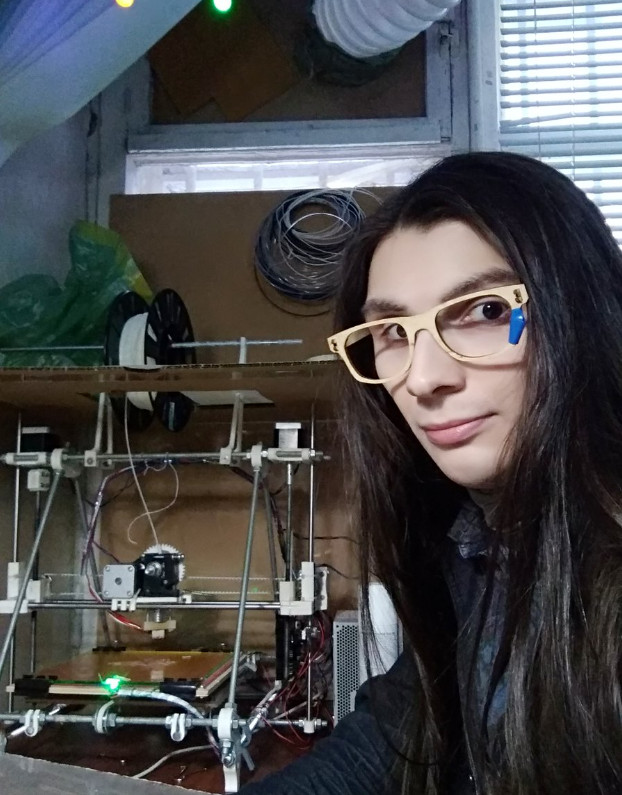
I am a midnight free software developer,
writing in Lisp and other PL in the name of good. During the daytime, he is the head of two laboratories at the Nizhny Novgorod College of Radio Engineering and just a teacher (I teach microcontroller programming courses, OOP, system programming, and GNU / Linux administration). As can be assumed from the text above, the co-founder of the Nizhny Novgorod hackerspace CADR. A little - a
poet , a little - a musician.
Main hobbies: reading, programming, playing keyboards (including attempts to write music - this is
an example , if anyone is interested).
Hackerspace can also be called one of my main and serious hobbies.
I read a lot of literature and news, mostly foreign. I actively follow the innovations of technology and science. I am interested in the subject of
transhumanism and biohacking. I want, if I may say so, to bring the future closer, and I believe that education is a contribution to the future.
One of the things that worries especially strongly is our life is limited and, since I am an atheist, I don’t wait for “life after”. Therefore, I am trying to change the world around for the better, as I can, here and now - since this is most likely the only thing we have. It is sad to see around superstition and prejudice, discrimination against people on different grounds. In my opinion, hackerspaces, through the popularization of technical creativity and science, help the world society to move from a dark past to a bright future.
Are you an incubator for any commercial project?
We, under the terms of our cooperation with the college, cannot conduct commercial activities. Some people at CADR have been working and are working on their own projects — probably commercial ones. But here I have no exact data.
How advanced is robotics in teaching in schools in your city?
In some schools, cities use Lego-robots in education. I will say more about this in the answer to the next question.
I do not have statistics on schools, but I will not express my own assumptions.
Do you think that robotics could attract children in schools to independent creativity, to better study of subjects?
Yes. Robotics allows you to "touch" many interesting things, such as programming, electronics; also allows you to develop the engineering skills of a person from an early age. From experience, I can say that the most prominent specialists with whom I have to communicate, began to engage in technical creativity in school (many - from elementary grades). I myself began to program in school years and learned a lot in practice. He did this because it was interesting to me - in my school years my passions were experiments with graphics in Pascal. It was clear and looked spectacular (at least for me at that age.) But, for example, I saw the applicability of knowledge of the English language later when I began to read interesting things for me in a foreign language. This is where the progress in learning English began.
In my opinion, now many technical things are taught abstractly from practice, and people do not see the applicability of the knowledge that they receive. Previously, children more actively helped adults in their work and studied in practice. By the way, this is interestingly
said by Paul Graham in his book
Hackers and Painters . And now you need to study for about a dozen years at school and about half of this time at a higher educational institution in order to start doing something seriously in the technical field. Or so, at least, we are taught to think. Although this is all relative. I remember that I was impressed by the
example of Jamie Zavinsky , who became an outstanding programmer and hacker (in the classical sense of the word), having only secondary education behind his back. That is, it is important practice. I think that if we are more active in attracting people from an early age to interesting projects, then we will have much more competent technical specialists - probably, this is even more important than the basic education system with grades and exams.
However, it is not enough just to add robotics to schools; one must also choose a platform for learning wisely. Lego robots that are popular now can be a good start, but limit children to more serious work, partly because of their proprietary nature and a fixed set of parts, partly because of the high cost of the kits. I think a more promising direction is the use of the Arduino platform and 3D printing and laser cutting technologies to create robots. Yes, it is more difficult - but on the other hand, Arduino is available to everyone and even a school student can afford to buy one of the variants of this platform, instead of buying some chips. ;-)
3D printing is also becoming more accessible to the general public — for example, we have several printers in college, and CADR has two publicly available ones. There was also a children's center
"Kulibin" , located at school 113 - they also have a 3D printer and a laser cutter. That is, these technologies come into use.
But even if you do not have access to a 3D printer or a laser cutter, the basis for the robot can be purchased ready-made or ordered for cutting, and it will still be cheaper than lego-robots. You can use a 3D printer in our CADR, for example.
In general, if you have a project to work on which you need space and resources, then come to our CADR hacker space - or the hacker space nearest to you.
A list of active hackerspaces around the world can be found at hackerspaces.org. Separately on our website we maintain our own
list of hackerspaces in Russia . If there is no hackerspace around you, then organize a new one. This is exactly how the emergence of new hackerspaces. If I did it, then you can too.
Links
The article is distributed under the terms of CC-BY-NC-ND 4.0